Vasco Da Gama Clip Art Vasco Da Gama Clip Art Step by Step How to Draw Easy
Although it will certainly be a while before many Fodorites will go the take a chance to become to Portugal, in that location will someday exist a fourth dimension when things render to normal, and perhaps finishing this trip report will provide some pleasure to currently domicile-restricted and increasingly restive travel bugs.
My flight out of Baltimore for JFK didn�t go out until 5:15, and my departure day was a Saturday, so I had fourth dimension to practise some things around habitation earlier in the solar day. When I first turned on my calculator this morning time, the image that popped upwardly on Bing was, of all things, a stunning overhead view of an eroded limestone cliffs and a small-scale sandy beach nearly Portimao on Portugal�s southwestern Algarve coast! (You can find the image here: https://www.bing.com/images/search?q...mageBasicHover. ) Barely ten days later, on Wednesday, May 8th, I actually was in Portimao and took a tour forth the cliffs east of the town, both by route and by sea, but I didn�t come across this precise spot (information technology�s apparently along the declension a brusk altitude w of Portimao). Still, it further fired my enthusiasm for the trip ahead.
My Delta flight from JFK to Lisbon was on a Boeing 757, just 6 seats across, the smallest plane I had always taken across the Atlantic. This reflects the bottom demand for both business and vacation travel to Portugal, which likewise isn�t a place many people go through on their mode to somewhere else. The food was fine, as information technology is on Delta international flights, and I managed to get virtually four hours of sleep.
We landed in Lisbon on Sun, April 28th, at about ten:00. It was a beautiful day, and I rode into the middle of Lisbon in a taxi with a talkative young driver who spoke excellent English language. (I realized over the class of this trip that fifty-fifty beyond the fact that Portugal and England accept been military allies since the belatedly 1300's, and also had strong mercantile ties for centuries because of the Port wine merchandise out of Porto, the southern coasts of Portugal and Kingdom of spain today function as England�s answer to Florida � the place where everyone flees for sunshine during the months of cold and moisture. Thus, you will most never take a trouble finding fluent English language speakers anywhere yous are probable to be.)
I reached my hotel, the Santa Justa, in downtown Lisbon�s Baixa commune, but due south of Rossio Square and the Praca de Figueira. This district was totally flattened by the terrible earthquake of November 1755, and and then rebuilt by the Marquis of Pombal, the rex�due south chief government minister at the time, on a regular grid plan. The Rua Augusta, the Baixa�s main artery, is a broad pedestrianized thoroughfare, every bit are many of the east-westward streets, and the other north-south streets are relatively narrow and easy to become across when walking.
Baixa is a nifty base for touring Lisbon � you�re in the center of everything. The districts of Chiado and Bairo Alto, with their shopping and restaurants and fado music venues, are respectively most a five- and 10-12 infinitesimal stroll to the west. Rossio station, your jumping-off place for the palaces of Sintra, is about an eight-10 infinitesimal walk to the north. You tin get to the Castelo Sao Jorge to the east (with the Alfama beneath information technology) on foot in about 15-20 minutes. The Praca de Comercio, the huge square on the waterfront that marks the site of Lisbon�s pre-earthquake royal palace and subsequently the seat of its main authorities ministries, is a ten-fifteen minute directly walk to the south.
Because of the advantages of its location (and the inexpensiveness of many of my other hotel accommodations), I was willing to splurge on the Santa Justa, which, with taxes, toll me effectually $250 a night for my room. It�s at the intersection of the Rua de Santa Justa and the Rua dos Correeiros, both of which are pedestrians but, occupying buildings on both sides of the latter, and was one cake s of the Praca de Figueira (which has an underground parking garage that you lot use if y'all accept a car). It presently ranks 19th out of 289 hotels in Lisbon on TripAdvisor (with current rates in the low $200's).
I had requested a room with a view when I�d booked my reservation a couple of months earlier, so they put me in a corner on the acme floor of their annex building beyond the street from the master lobby. There was a bit of the �exist careful what y'all wish for� about the management�s gratification of my request, because this was a garret-level room simply under the roof, with slanting ceilings and projecting beams, and I am 6'2'�. Yes, there were a few head-bumps in the early on going until I got accepted to information technology. Merely: information technology had doors opening to small balconies (with room for just two chairs each) on both the Rua Augusta and the Rua Santa Justa side. From the latter, I could wait west a couple of blocks to the elaborate fin de siecle ironwork of the Santa Justa lift and its observation platform, which was designed past none other than Gustav Eiffel. (I loved being able to come across it illuminated by dark.) To the due east, I could see the walls and towers of the Castelo Sao Jorge crowning its imposing barefaced, where the original Moorish settlement had been located. And in front and to the sides of me of me were lovely nineteenth century buildings painted in an assortment of pastels � peach, flax, rose, pearl gray, cornflower blueish.
Here is a flick of the view from one of my room�southward balconies:
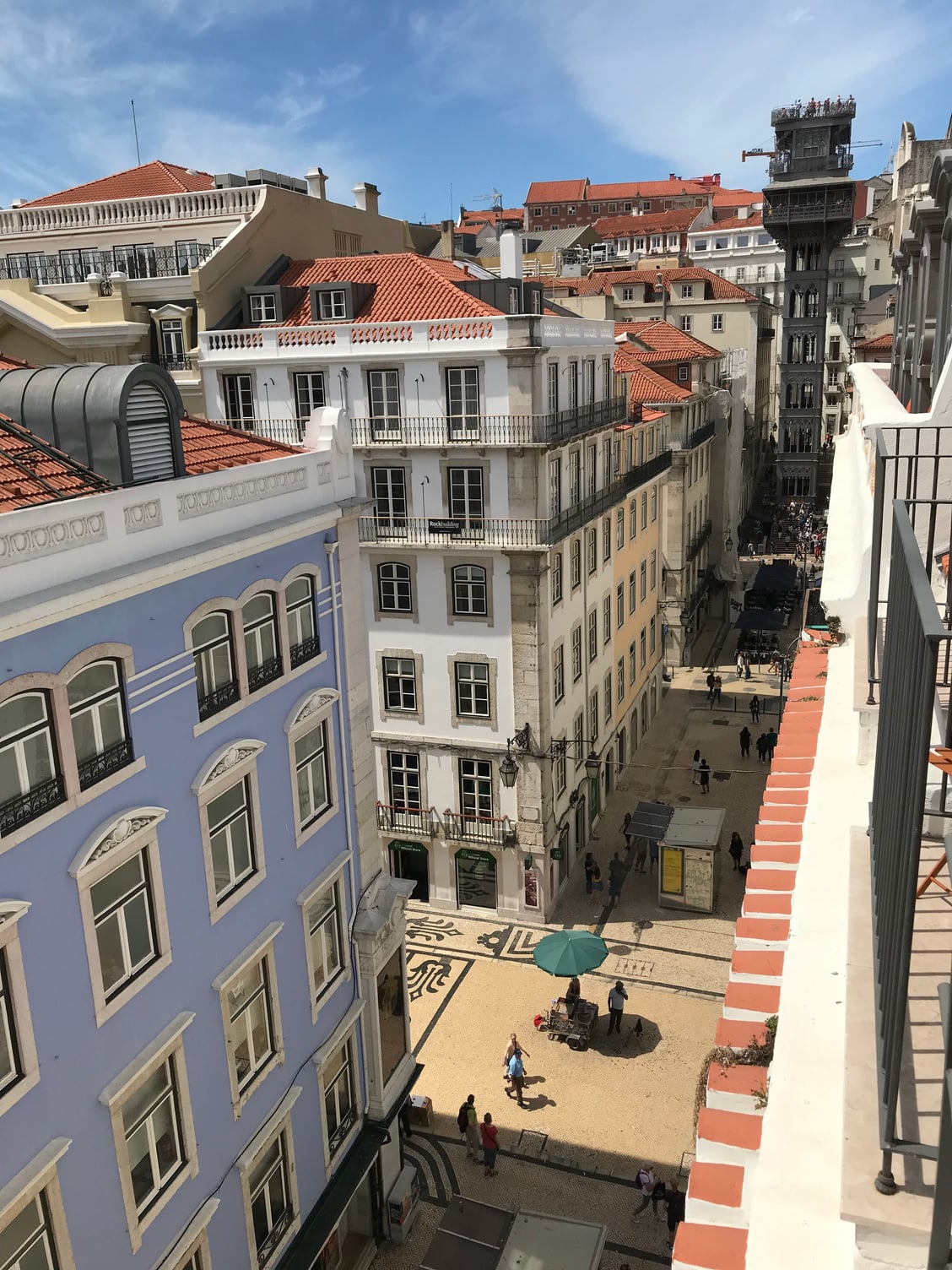
It was a beautiful sunny afternoon, with blueish skies and the temperature in the depression seventies, with a bit of a breeze. I was excited and eager to be out and touring, so I changed into a polo shirt and a pair of shorts and ready off � making two mistakes equally I did so. First, I raced off without my guidebooks, although I did have a map. 2nd, probably in office because I needed to get more than Portuguese currency, I didn�t go out my wallet backside in my room condom. More about that afterward.
My objective for the afternoon was the Belem commune, about 2-1/2 miles west of the downtown surface area on the Tejo (Tagus) waterfront), because I�d read that a number of the primary sites there (including the Belem tower and the Jeronimos monastery) were closed on Mondays. (This is actually pretty common in Portugal.) I defenseless the famous # 28 tram from a corner of the Praca de Figueria, and once I took my seat and stopped rushing effectually, I realized I�d forgotten my guidebooks. But I shrugged information technology off, figuring I�d read enough almost the places I�d be seeing that I could go by, and then fill myself in on the further details that nighttime.
When I reached Belem, I passed past the legendary pastry store called the Pasteis de Belem, celebrated for making the small custard tarts known every bit Pastel de Nata, and which had been highly recommended to me. But the lines were downward the block, and I didn�t feel I could spend the time to wait. So I continued on to the famous waterfront belfry of Belem, which may be Lisbon�southward best-known landmark. This was built every bit a wait-out and cannon platform at the western entrance to Lisbon�s shipping basin in 1515-1520, but it is far from a grim fortress. It was synthetic past the architect Francisco de Arruda (whose work I would come across once again afterwards on at Tomar) in the fanciful Manueline style named later on King Manuel I (1495-1521), which typically combines Muslim decorative influences (such equally double-arched windows and elaborate Moorish canopied balconies) with organic marine and nautical (specially ropework) elements. Hither, fifty-fifty the most functional defense elements had decorative touches � the shield of Portugal�southward crusading order, the Gild of Christ, was embossed upon every battlement; the sentry boxes were crowned with segmented domes reminiscent of a citrus fruit; and the posts at the top of its towers were each capped by small pyramids.
I had plenty to time to contemplate this architectural fantasy � which reminded me of an elaborately decorated rook that had escaped from a giant chess lath � because the Female parent of All Lines snaked abroad from it, commencing at the end of a span crossing over the surrounding low-water mud flats and then wending its way along the sidewalks of the adjacent park. Eventually, I learned that this line was a function of the upper limit of 120 people who are allowed into the belfry at whatever 1 point in time. I had some time to spare, so I waited, and and so at most 2:40 p.m., the line suddenly lurched forward and filled up the bridge, and it looked like nosotros were getting somewhere � until I noticed a sign at the water�s edge indicating that the last admission was at ii p.m. today. I then realized that although people were withal periodically exiting the entrance, it didn�t seem like anyone was being admitted.
Beingness a pushy American, I crossed the bridge, rapped upon the door, inquired, and established that, indeed, no one else was going to get inside today. Given that at that place were all the same several hundred people waiting patiently � or perhaps dumbly � in line, I shook my head in atheism that no staff fellow member could be bothered to take a moment to footstep outside and make an announcement to this event. So on my way back beyond the span, I announced �closed� in every European language in which I knew the word. A few of those waiting peeled off in response to this, simply not many. As I worked my way around the land side of the belfry taking photos from the waterfront park, they recorded a still-lengthy line of hopeful visitors waiting patiently simply pointlessly in line. If zero else, I felt I�d gained an insight into both the arrogance of Portuguese officialdom and the stolid mentality of too many native and foreign tourists.
Here is one of the photos I took of the Belem Tower:
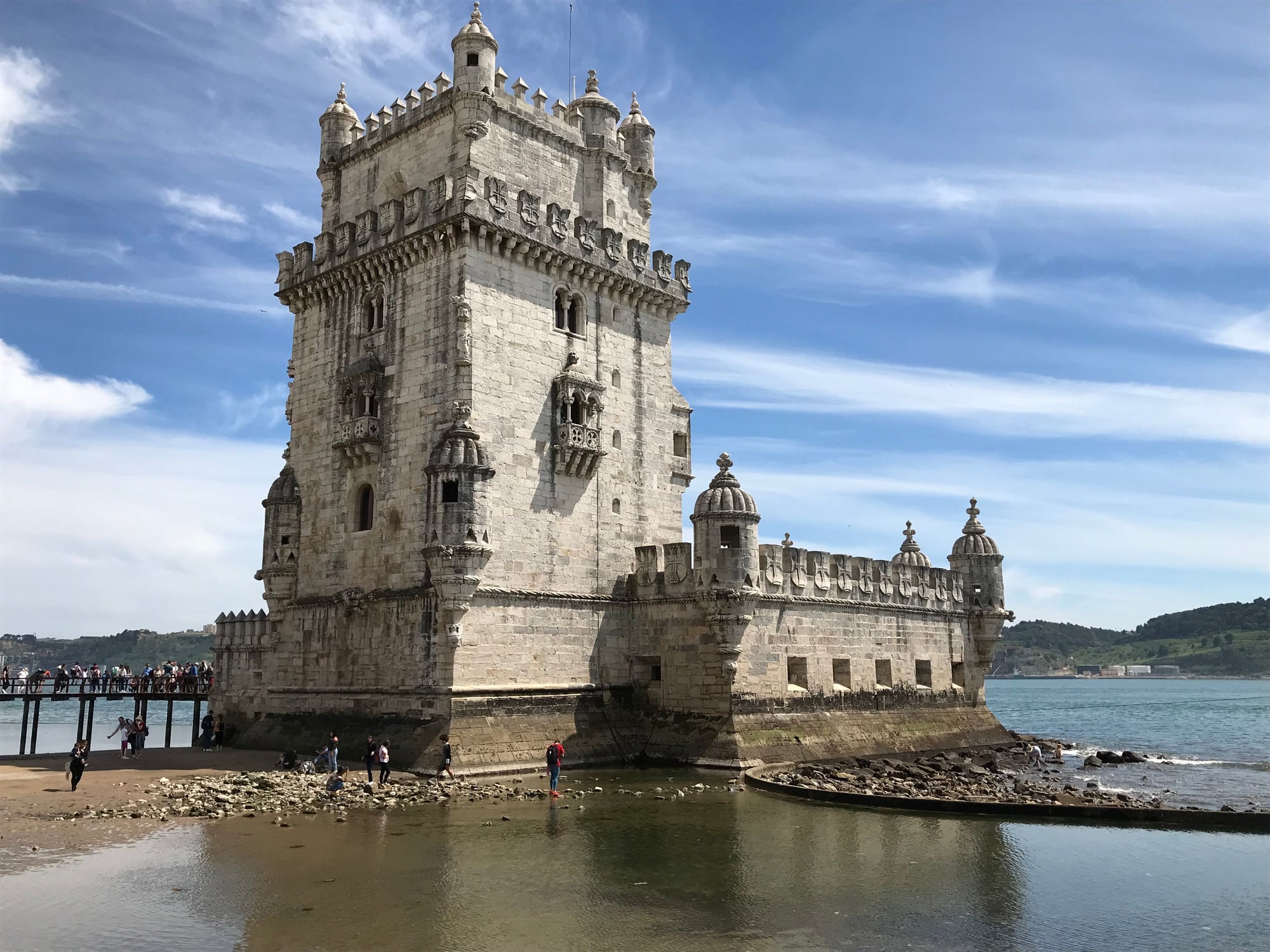
I fabricated my west forth the waterfront to the giant and striking �Monument to the Discoveries,� erected by the fascist Salazar regime in 1960 on the 400th anniversary of the death of Prince Henry the Navigator, whose school of navigation, commerce, and diplomacy at Cape Sagres (the site of which I visited the following week) did so much to spur the Age of Discovery and the onset of Portugal�south 16th century Golden Age. In form, it takes the shape of the loftier, jutting prow of a ship, lined on each side with thirty-plus statues of the neat figures of Portugal�s Age of Exploration, with Prince Henry at the apex and Luis de Camoes, clutching the text of Portugal�s national epic, �The Lusiads,� prominent among the figures on the right side. Above them looms a tall stone tower crowned by an observation deck with views over the Tejo estuary and representations of billowing sails on each side. In that location was a line to get upwards to the top, and while information technology wasn�t all that long, I felt I didn�t have the fourth dimension. Afterwards, though, I read in Rick Steves�s Portugal guidebook that the view of the estuary from the pinnacle and of a giant mosaic pavement in forepart of the monument that depicts Portugal�southward great voyages is worth the await if you can be patient.
Information technology was only as I walked away from the monument towards the Jeronimos monastery that I noticed that the monument has a giant representation of a cross-like sword on its narrow landward face up. When I read Roger Crowley�s �Conquerors: How Portugal Forged the First Global Empire� afterward my render, I felt that was an appropriate representation of the mix of motives and ways that characterized Portugal�s amazing outward expansion in the first half of the 16th century.
Here are two photos of the Monument to the Discoveries:
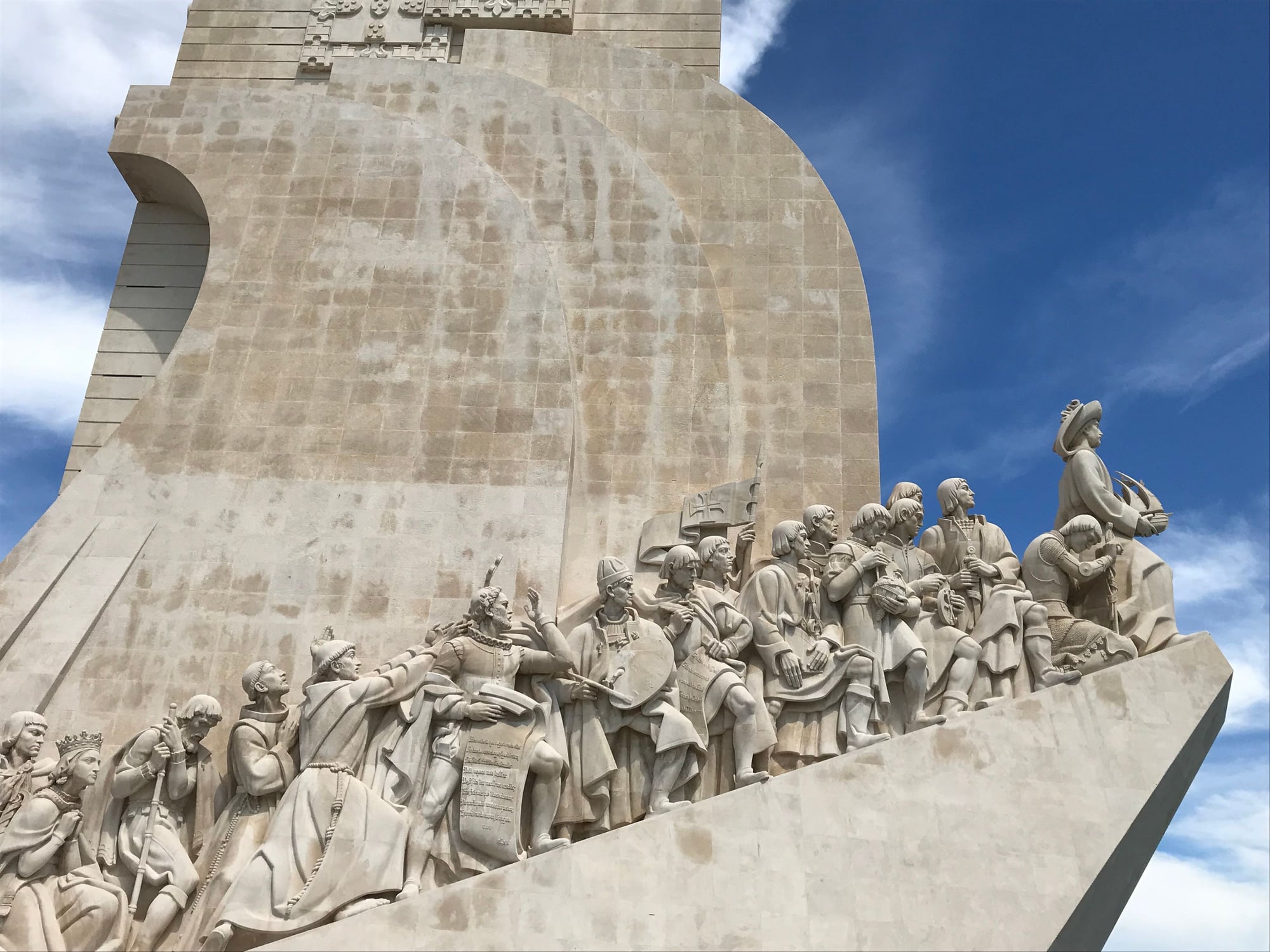
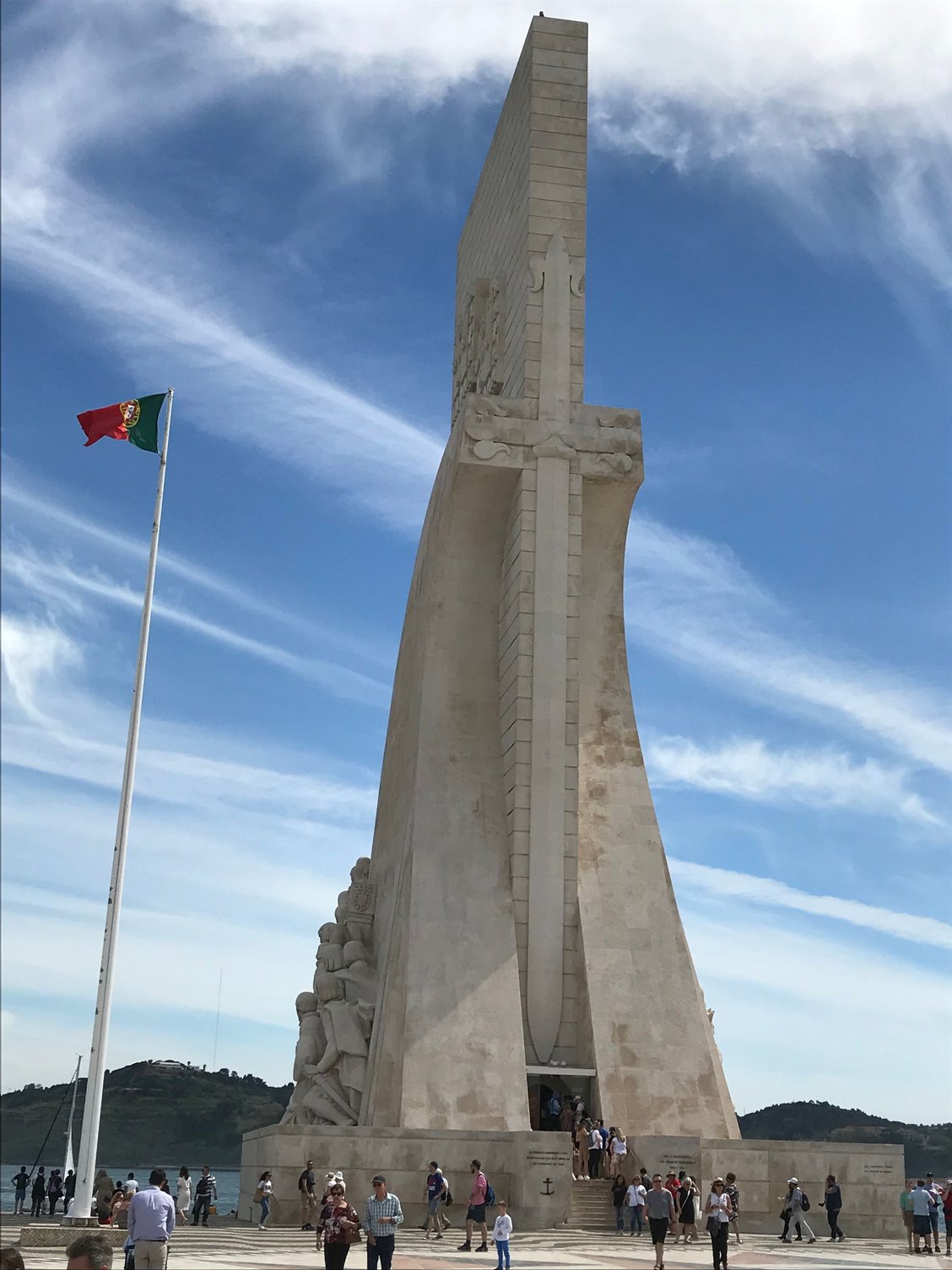
The Monument to the Discoveries stands where it does considering this was the bespeak of deviation for Vasco da Gama�s fleet on July 8, 1497 and of the return of its survivors from their all-important voyage to India two years later on. It�due south worth taking a moment to imagine the scene in your mind. The bay is pretty shallow at that point, and boats passed to and from the iv ships continuing offshore carrying provisions, needed equipment, and coiffure. When the ships stood out to sea, a oversupply that included the family members and friends of those aboard lined the beach and waded out into the bounding main to see them off, doubtless with great feet as to the likelihood of their safe return. In the end, barely a third of them did.
King Manuel I started construction of the Jeronimos Monastery 3 years later in thanksgiving for the safe return of Da Gama and his last two ships, which had opened up an arduous and lengthy (round trip: 18 months) simply immensely lucrative trade route to the east that allowed the Portuguese to cutting Venice and the Mamelukes of Egypt out of their roles as the middlemen in the spice trade. The Jeronimos complex consists of the massive church, with an elaborately decorated s facade facing the bay, and an elegant two-story cloister on its north side. The church building is imposing, with half dozen relatively lean and tree-like columns carved with vegetal motifs that shoot up 80 feet above your head to the springing arches of the vault. Two Portuguese kings - Manuel I and his successor Joao Iii (1521-57), along with their queens, are cached in the church building�south choir in tombs mounted on elephants, while Vasco da Gama�s tomb is in a small and easily overlooked (at least amidst the Dominicus crowds) chamber off to the left when you lot enter the church�s western portal. Luis de Camoes, whose actual burial identify is unknown, rates an empty tomb in some other small room to the right of the entrance.
Here is a photograph of the interior of the Jeronimos Church:
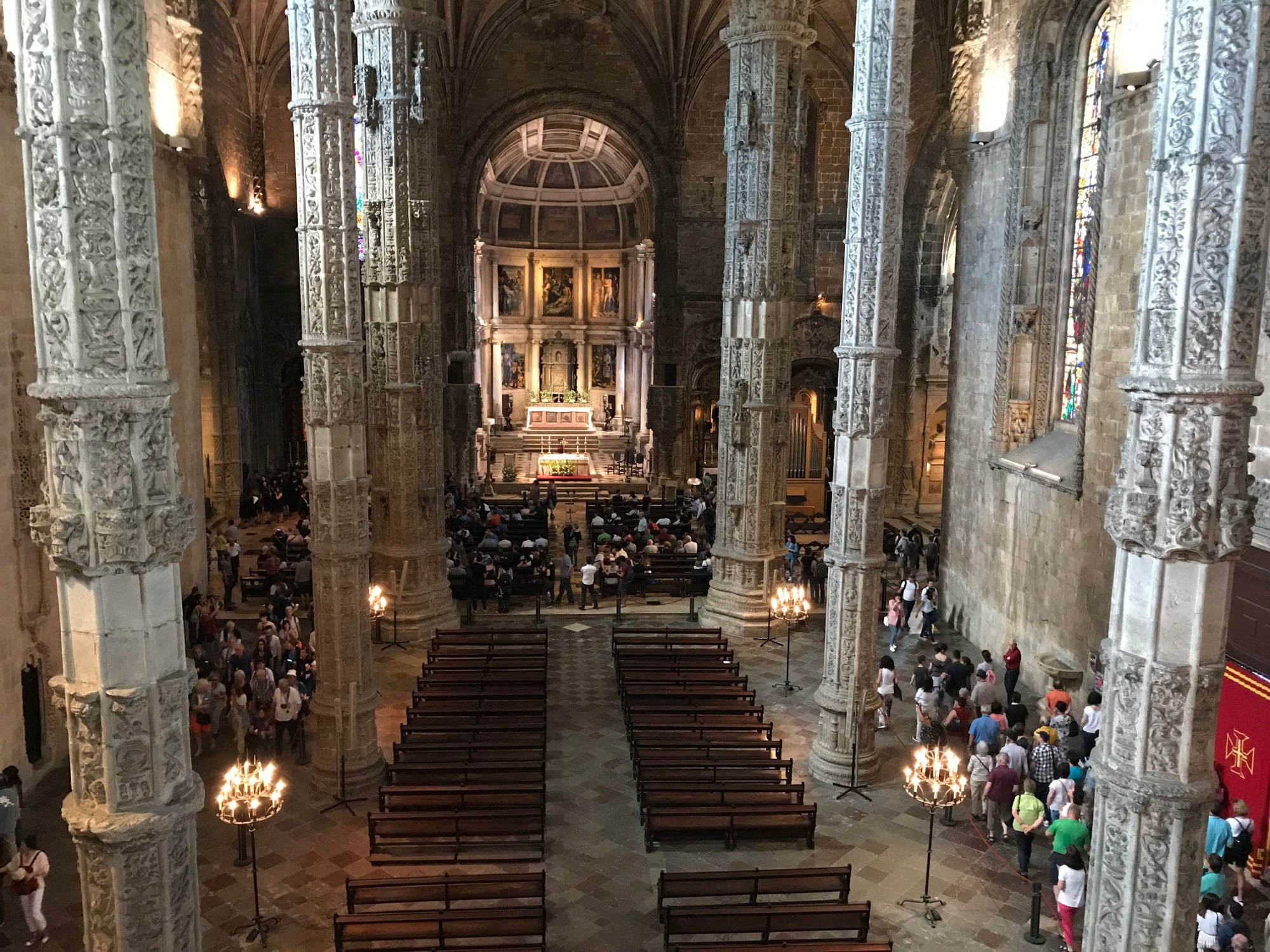
I liked the church, with its lofty columns and vaulting, but I thought the cloister was the highlight of the Jeronimos circuitous. It is an practise in full Manueline exuberance, with elaborately filigreed arches, busy columns and pinnacles, and abstract designs and representations of vines and flowers that embrace nearly every inch of its surface. And the tawny colour of its stone was beautifully set off past the bluish sky and its grass lawn basking in the Lusitanian sun.
Here is a photo of the Jeronimos cloister:
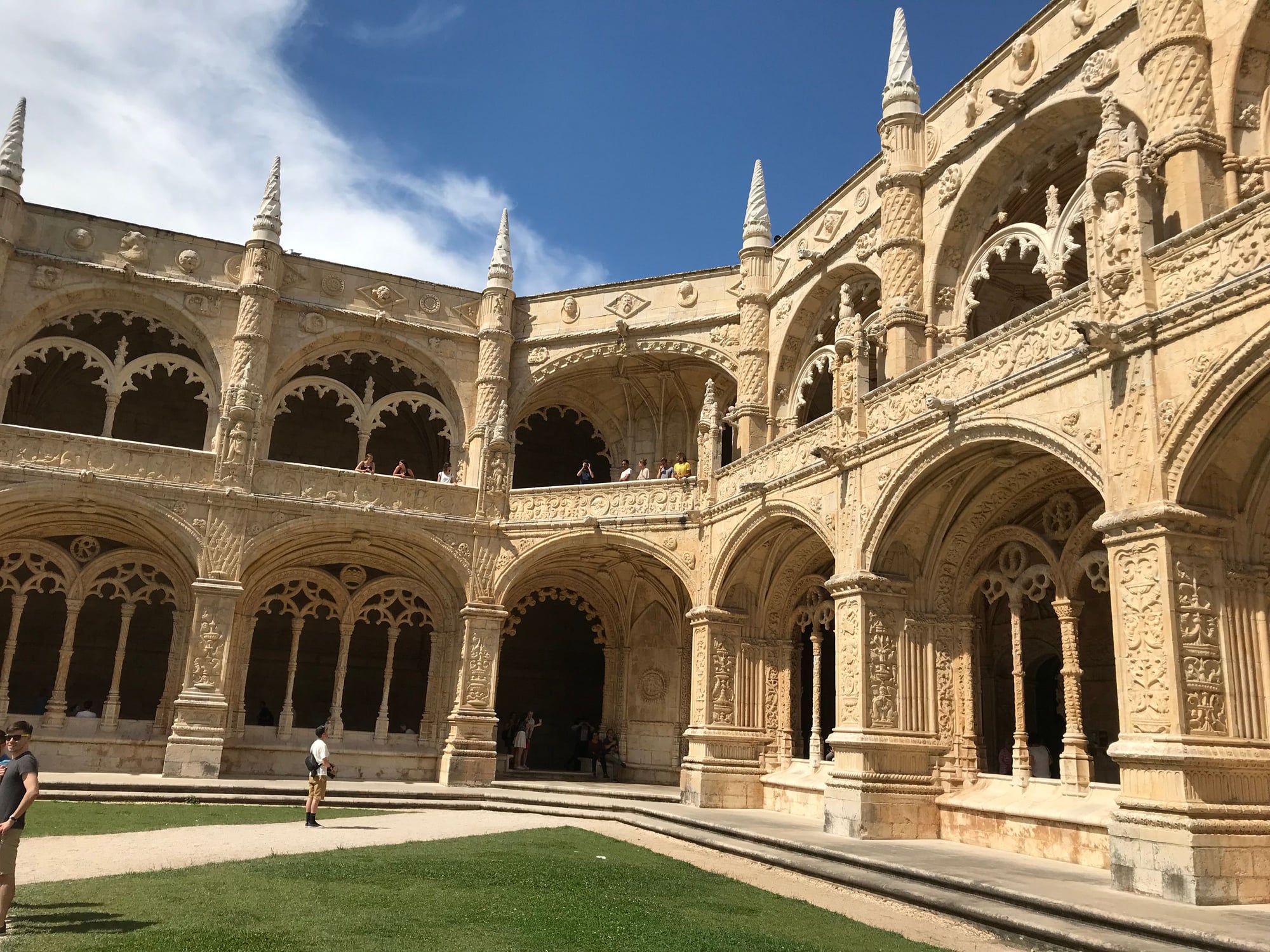
By the time I finished with the Jeronimos, it was pushing four:10. I knew I�d need to scramble in order to catch the 4:30 walking tour that I�d booked with the Lisbon Chill-Out Gratuitous Bout company. It started from the Praca Luis de Camoes, which is on the southern edge of Bairo Alto and just west of Chiado � a couple of miles away from where I was and then. I was able to catch a taxi in front of the Jeronimos, and the driver took me speeding and swooping beyond Lisbon�s hills like a Swift before depositing me where I needed to exist with but minutes to spare.
The Lisbon Chill-Out Free Tour company is a small, locally-owned enterprise with an interesting business concern model. They accept no set charge for their tours; y'all pay what you want to or can at the end. Pretty much anybody does, based on the quality of the service provided, and so it seems to piece of work. TripAdvisor gives it 5 stars based on v,253 reviews.
Our tour was led past a young woman named Ana, who also had a trainee in tow. At that place were virtually 15-20 people in the group, and a various crew we were, including a trio of American girls, a young Brazilian woman, and an older British woman, and a young couple or two.
Ana was great: personable, engaging, and knowledgeable, as well as possessing the necessary skill at cat-herding that is also vital for a tour guide. The bout ran a solid 3 hours, and Ana did it in an urban setting with some level of street noise much of the way with no microphone, and I never had trouble hearing her. (I requite walking tours in my own metropolis, so I know just how challenging that tin can be.) She kept us on the movement, and her tour was filled with solid content and provided a expert initial overview of much of downtown.
We started out past making our manner through the Chiado, showing off the entertainment, restaurants, and shopping information technology has to offer, and and so arrived at the Largo da Carmo simply in time to catch the lowering of the flag at the National Guard headquarters, which is carried out with a caste of pageantry and does concenter a crowd (at least on Sundays). This was likewise where the Portugal�s last dictator, Marcello Caetano, was cornered and captured during the�Carnation Revolution� of April 25, 1975. We were there simply iii days by the 45th anniversary, and the square featured several large black-and-white blow-ups of photos taken that twenty-four hour period. One of them showed a male child, perhaps ten or xi, with round, nighttime eyes holding the hand of a soldier; it was odd to call up that he would now be a man in his mid-50's, deep into a life and career.
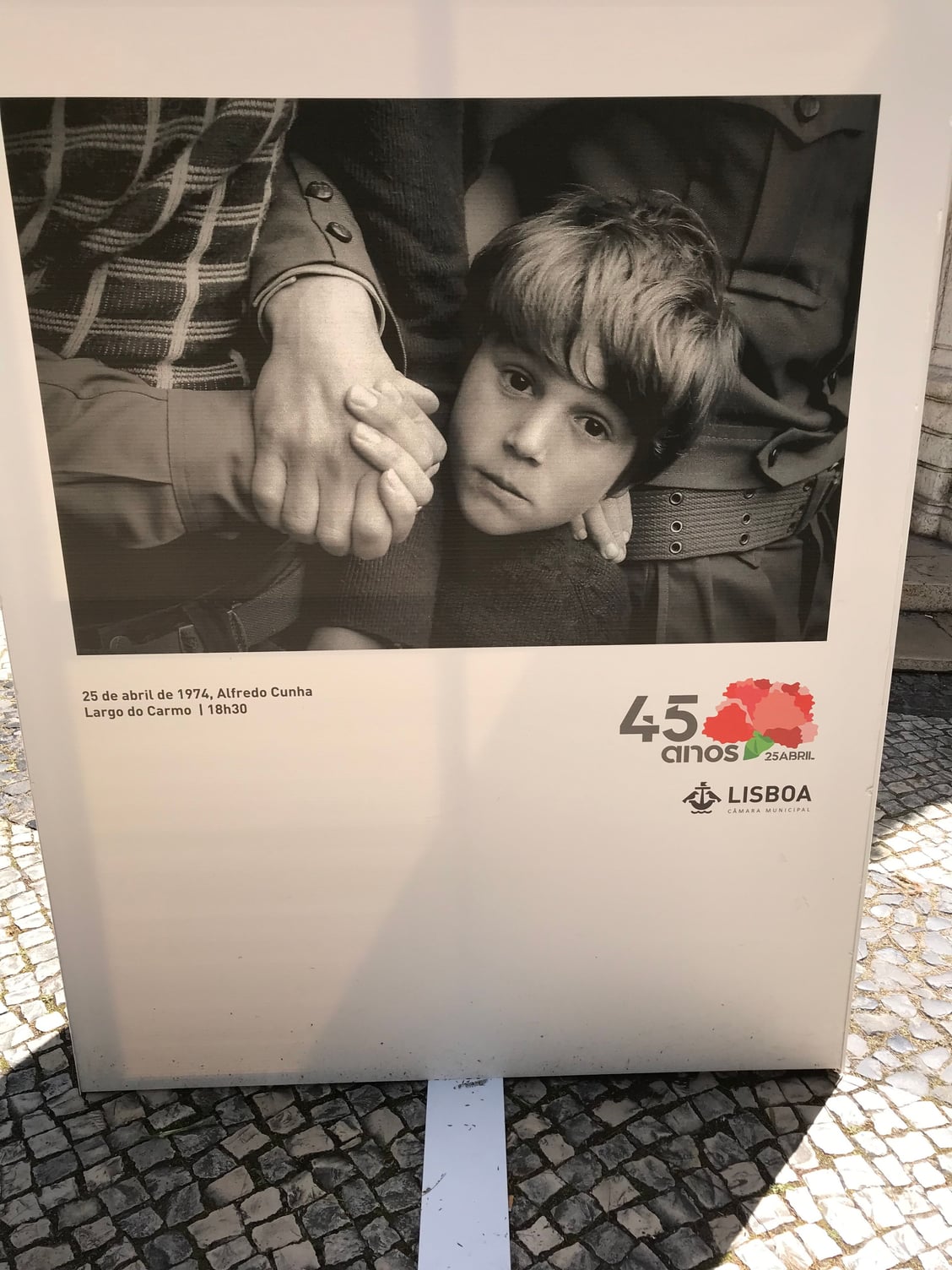
The ruins of the 14th century Carmo monastery, which was partially wrecked during the Keen Convulsion of 1755, adjoin the National Guard headquarters, so Ana took that as an opportunity to cursory u.s.a. on the almost traumatic 24-hour interval in Lisbon�due south history. From in that location we walked downward to the vast foursquare of the Praca de Comercio along the waterfront � in one case the site of Portugal�southward pre-earthquake royal palace and later of the great regime ministries � and then east to the Alfama, the erstwhile neighborhood that was in one case the Moorish metropolis. Along the way we passed the hit 16th century Casa dos Bicos (�House of the Facets�), one time the home of the Albuquerque family and today a foundation honoring Portugal�s Nobel Prize Winner in Literature, Jose Saramago.
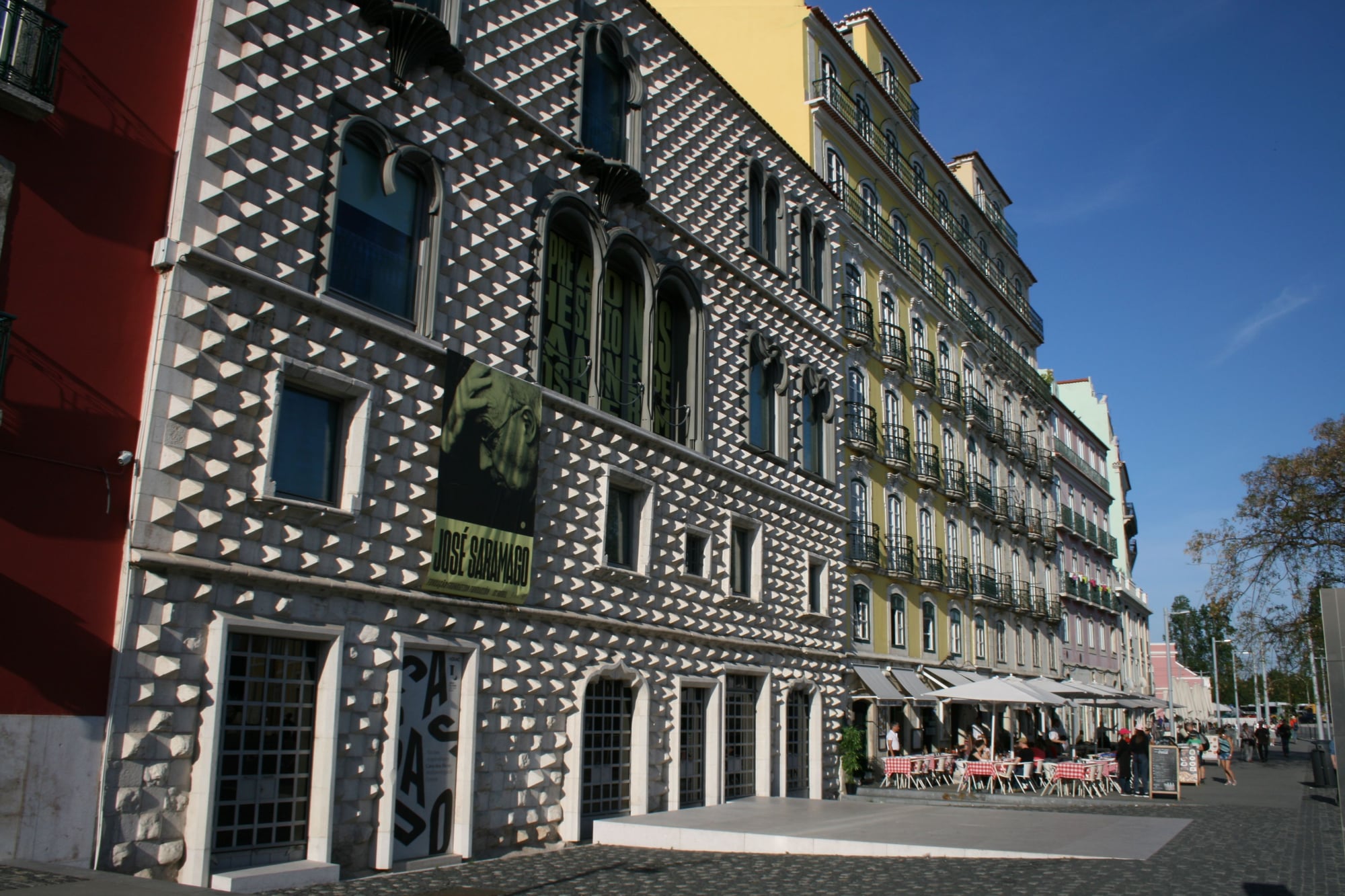
Nosotros passed close by Lisbon�s Se, the city�south 12th century Romanesque cathedral, just didn�t finish. Instead, nosotros worked our way upwards through the narrow and winding streets of the Alfama (with a stop to sample Ginginja, the traditional cherry liqueur served in small chocolate cups) to the Largo St. Luzia, a plaza/overlook next to a pocket-sized church building that commanded a spectacular view of eastern Lisbon, the Alfama below us, and the bay beyond. The tour ended there, and I made my way over to the railing along the overlook and started taking photos by the lovely belatedly afternoon light. This is the Church of Sao Vicente de Fora (1582-1627), which serves as the mausoleum for Portugal'south terminal ruling dynasty, the House of Braganza:
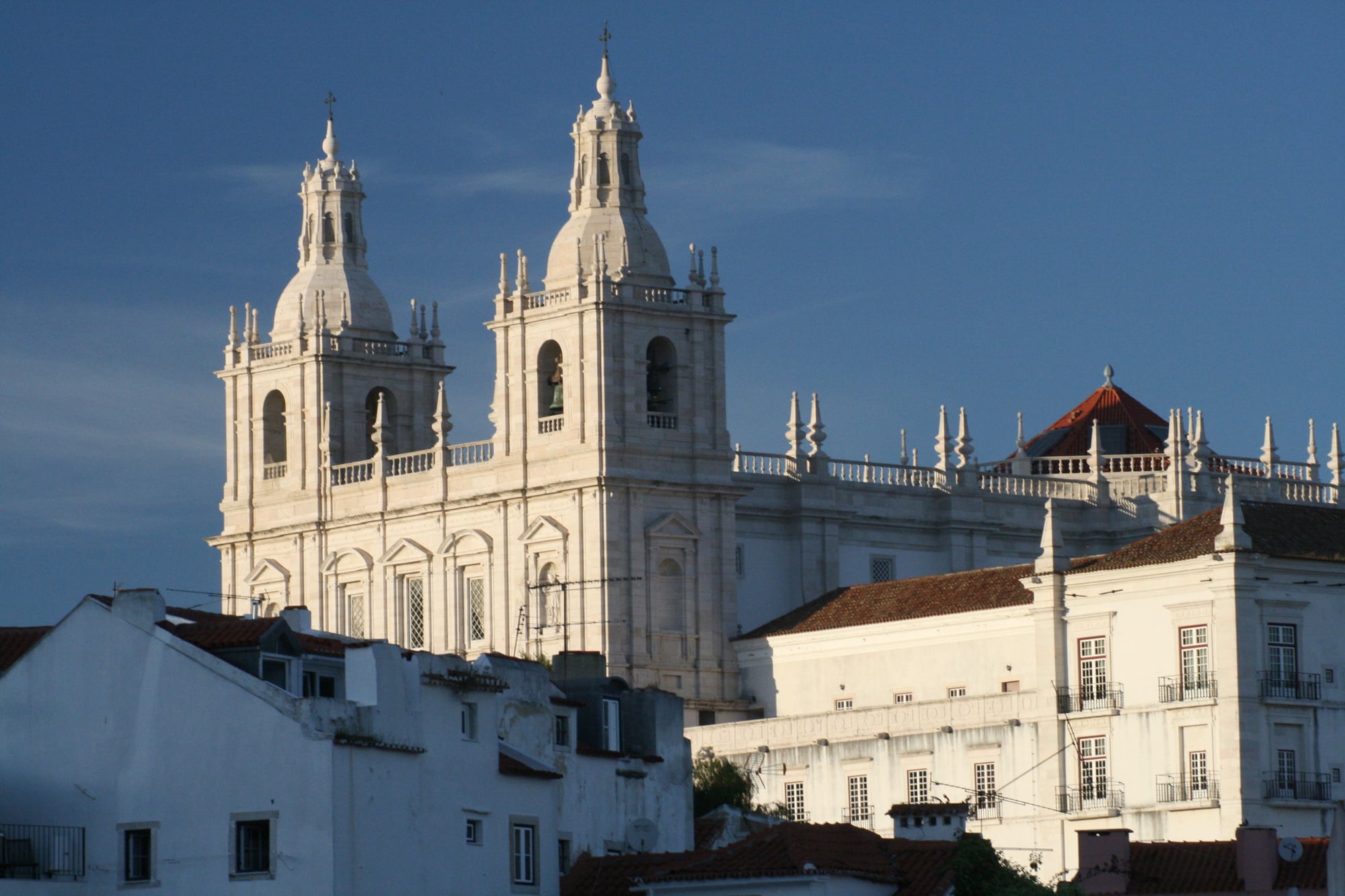
I got some very nice photos � and I too got my pocket picked while I was concentrating on the view in front of me, rather than who was behind me. For a more detailed business relationship of that (mis)adventure and the lessons I took from it, come across my post beneath:
Pickpocketed in Lisbon: A Memoir
Later on I finished reporting the crime to the police at an function near the Rossio station, I ate a late dinner back at the Santa Justa, just was in no mood to enjoy it. The waitress did her best to jolly me up, however, and her vivacity did help elevator my spirits -- as did my view by night of the Elevador Santa Justa later on I returned to my garret room:
Bated from the big lesson � don�t get your pocket picked! � I would say my primary take-aways from Day 1 were that (1) Lord's day�s not a great day to get to Belem: information technology�s but too crowded; (2) whenever yous do go, try to do it starting time thing in the morning time, when the crowds hopefully haven�t yet massed and the lines formed; and (3) remember that there�s as well a quintet of museums there � of archaeology and ethnology; military history; maritime history; pop and folk fine art; and a unique one that houses the ornate equus caballus-drawn coaches of the Portuguese imperial family, which seems to offer something for everyone. Oh, aye, and many people exercise not regard as trip to Portugal as complete without visiting the Pasteis de Belem.
Source: https://www.fodors.com/community/europe/portugal-a-photographic-trip-album-1675605/page2/
0 Response to "Vasco Da Gama Clip Art Vasco Da Gama Clip Art Step by Step How to Draw Easy"
Enregistrer un commentaire